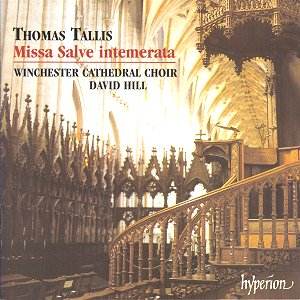Thomas TALLIS (c1505-1585)
Missa Salve Intemerata Votive Antiphons: Ave rosa sine spina and Salve
intemerata and Fantasy in A minor for organ with various plainsong
antiphons
 Winchester Cathedral Choir/David
Hill; Philip Scriven (organ).
Winchester Cathedral Choir/David
Hill; Philip Scriven (organ).
Rec Winchester Cathedral May 2000
 HYPERION CDA 67207
[67.50]
HYPERION CDA 67207
[67.50]
Crotchet
AmazonUK
AmazonUS

With this CD Winchester Cathedral choir show themselves to be as fine a group
of voices as you will find anywhere. This is Tallis before the Reformation,
composing in that massive late Tudor style not unlike Shepherd and Fayrfax.
This is music which requires stamina, commitment and very sensitive musicianship
from everyone concerned. The boys are required to soar constantly in their
upper register with long lines and phrases in an ever-constant polyphony.
Not many cathedrals are tackling this kind of repertoire. It takes time,
considerable effort and above all there must be a suitable opportunity to
perform these works liturgically, and that is not always possible. Where
is it possible now in normal Sunday worship to put on a 15 minute Latin antiphon,
let alone a polyphonic mass weighing in at over 30 minutes? My impression
is that the choir had performed this mass in public before recording it,
as it has a fluidity and confidence gained from an unrushed knowledge of
the piece.
Yet this music is not as massive and as complex as some slightly earlier
composers who have featured on fine if little known recent recordings.
A generally agreed date for this mass would be c.1538. Tallis was in his
early 30s. It is in 5 parts but with the tenor partbook missing it has had
to be reconstructed using the motet recorded here as a guide. Even at this
period there was a mood in the air to begin to simplify and purge polyphony
of the over-elaborations of the previous generations. For example this mass
altogether lasts for less than 30 minutes (as was standard at the time there
is no polyphonic Kyrie which was sung instead often to troped plainchant
as here). Compare that with three other masses recorded recently: Richard
Pygott's [1485-1549] Missa Veni Sancte Spiritus (Christchurch Oxford on Nimbus)
40.39, the Missa Jesu Christe by Thomas Ashwell (1582-c1525) again recorded
by Christchurch Oxford for Metronome, 43.21 and the Missa Albanus by Robert
Fayrfax (1464-1521) recorded by Cardinall's Musick which takes 42.12 to sing.
Learning this music is a major undertaking for all concerned.
As I have said the choir is brilliantly prepared and on good form, the tenors
though seem to be a little recessed in this recording, is there a reason
for this? I quote from the booklet notes by Andrew Parker "… with modern
choral training, in some cathedrals the vocal power of around sixteen boys
can hardly be supported by … six men, the effect can too often be one
of the preponderance of the top line … rather than the riches and equality
of the texture." He goes on to say that at the time of recording there was
illness amongst the boys so that a considerably smaller group was used "which
far better balances the vocal forces of the men in this music". Did the recording
engineers overcompensate and microphone the boys too closely, making the
tenors, and at times the altos, a little too distant? You will anyway need
to turn the volume rather higher on your amplifier than is usual. You will
find yourself positioned at a little distance from the choir perhaps in the
choir area but only just in front of the screen. It's interesting that in
the Oxford recordings mentioned above you are positioned where the conductor
stands. With incidentally a choir of 14 boys and 15 men listed in the booklet.
Being Christchurch Oxford the architecture demands a more intimate recording
which is not only easier but also probably necessary.
This is not a reconstructed Lady Mass with yards of plainchant. What there
is has been well chosen and is appropriate to a feast day in honour of the
virgin, i.e., Ave Regina coelorum. The antiphons, each over 10 minutes, would
have been performed as part of the late evening worship in the Lady Chapel.
I am only sorry that there is only one organ work, surely there was time
available for one other?
To sum up. A very fine release, perhaps not always top notch Tallis in the
mass but the two large scale antiphons are superb and certainly worth the
cost of the entire enterprise.
Gary Higginson

